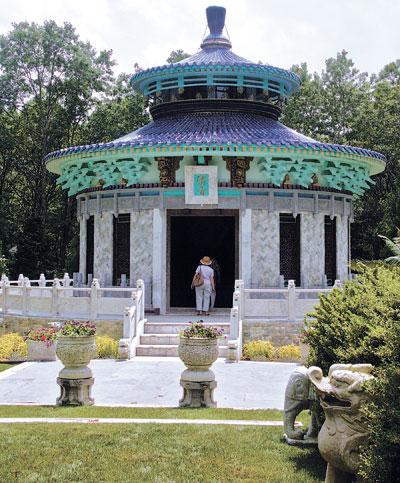From Beijing to Bridgehampton

Stanley and Susan Reifer's Chinese garden, hidden in the woods north of Bridgehampton, is something to behold. With a traditional moon gate, stone bridges, inlaid paths, waterfalls, and ponds with the requisite koi along with weeping cherry trees and oriental plants, the landscape takes those lucky enough to visit to another realm.
“I guess it's part of my search for immortality,”Mr. Reifer said, explaining that he wanted to create what is known in China as a scholar's garden. “But if you ask my wife,” he said, “she'll tell you it's just sheer lunacy.”
CLICK to SEE MORE PHOTOS
A turquoise gate at the entrance to the garden leads immediately to a pebbled path inlaid with two large Chinese characters. “It reads ‘House of Ray,’ which was as close as they could get to ‘Reifer,’ ” John Whitney of Whitney Landscaping said.
Although Mr. Whitney was largely responsible for the trees, shrubs, and flora, the garden as a whole was designed by a well-known Chinese Impressionist, Jian-Guo Xu, who is the Reifers’ friend. On his Web site, the artist, known by his last name, Xu (pronounced shoe), writes that his aim was to create “three dimensional paintings” in the landscape.
What might be called his brushstrokes bring together the four parts of a traditional Chinese garden – front, east, west, and back. The effect on uninitiated eyes is overwhelmingly dense — there are almost no open spaces. But in the East, the configurations of wood, stone, and water, along with splashes of green, would convey contemplation and serenity.
“There are no flowers just for flowers’ sake,” Mr. Whitney said. “We were going more for form and texture, and foliage color and contrast.”
Plants like bamboo, pine, and willow abound, and, in some places, they have been staged by the artist. Some large boulders are adjacent to one large and one small Norway spruce, an installation called “Mother and Child.”
The many rooms of the garden each have a different name and meaning. The patio, seen through the moon gate, is not designed for functionality but rather to gaze at. “It would be like sitting on a potato chip,” Mr. Whitney said, referring to its rippled ground.
Walkways lead around water features, over stone paths, and past plantings and statues that invoke Chinese history.
A koi-filled upper pond, with a waterfall, funnels by way of a stream into a lower pond, the water recycled by an invisible and silent pump. Imposing, huge sand-colored rocks filled with holes, brought here from China's Lake Ting, have been carefully placed in the landscape.
Groundcovers keep maintenance relatively simple, and tropical plants — like Lady palms and ginger — are removed from the ground for safekeeping over the winter.
“You don't have to use exclusively oriental plants to create an oriental garden,” Mr. Whitney said.
In one of the garden rooms, called the Child’s Garden, a weeping blue Atlas cedar with serpentine bark has been coaxed into an unusual shape that snakes toward the heavens. “It’s supposed to suggest longevity,” Mr. Whitney explained.
At one end of the garden, rising dramatically, is one of the garden’s most impressive structures — a replica of one of the buildings in the Temple of Heaven complex in Beijing. “It’s a junior structure,” Mr. Reifer said with a laugh. “The real one is 60 feet wide with three roofs; this is 28 feet wide with two roofs.”
Constructed of concrete, it has 500-year-old Ming Dynasty wooden doors, with metal handles containing animals that appear to be dogs. The interior wall of the temple contains a Tibetan-style landscape mural filled with mythical beings and gods. The room's furnishings are a Buddha, a prayer mat, and iron seats. Birds sang from the rafters when the visitor was there.
Looking back toward the house and garden from the top of the temple steps, you see several pagodas and pavilions rising above the bamboo and cedars, and the turquoise gate, which leads back to reality. The property is not large, altoigh its many levels fool the eye.
It is a garden of originality that honors the visitor with a dichotomy: soothing natural elements and dramatic ornamental structures. The overall effect is one of a grand vision that — while it may speak to a bit of lunacy — immortalizes the East on the East End.
[[nid:4527]]
